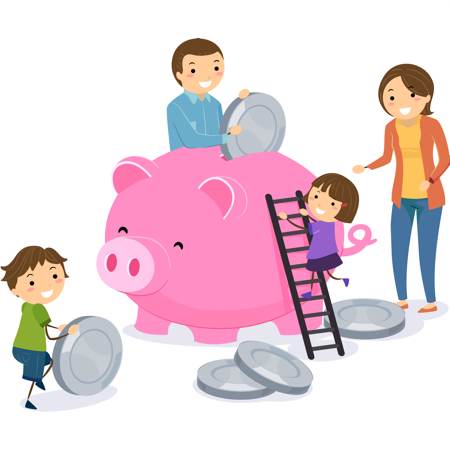Tax planning for families

Family tax planning is a smart way to utilise all of the exemptions and allowances legally afforded to you.
In the UK, every individual has a personal tax-free allowance and is taxed independently. This applies to working parents, retired grandparents and also children. Because of this tax structure, it is possible to use legitimate means to reduce the joint size of your family’s tax bill.
Strategic (but non-aggressive) family tax planning can benefit contractors, small business owners, and even working adults. If you plan to undertake some form of family tax planning, however small it may be, we advise you to speak with a qualified and independent accountant first, whether it is our team at TaxAgility or an equally experienced professional. To give you an idea about family tax planning, we aim to discuss family tax planning in detail and highlight essential areas in this article.
What is family tax planning?
Family tax planning is a tax strategy, which maximises the usage of the many tax exemptions and tax allowances that exist within the legal framework for members of a family household. Often this happens through the careful shifting of income from the hands of the primary wage earner to their spouse or children.
The rationale that dictates this strategy is that anyone who does not earn as much as the primary earner of a household will be taxed at a lower tax band. Therefore, the maximum amount of taxable income that can be legally transferred to another family member should be utilised to minimise taxes and maximise household income.
Every person in a household is entitled to an annual personal allowance (or PA) on any income. A personal allowance is a threshold above which income tax is levied on an individual’s income. The personal allowance for tax year 2019/20 is £12,500 for individuals earning less than £100,000 a year. Once the £12,500 threshold is hit during the tax year, that person has to start paying taxes on any income they earn that is above that amount.
For example, if you earn £10,000 in the 2019/20 tax year, you do not have to pay any tax for that year. But if you earn £200,000 in the same year, you will lose your personal allowance and pay a higher tax rate on the vast majority of your income.
Examples of family tax planning strategies
Finding ways to spread income across various members of a household is the key to minimising the amount of tax which your family will pay in a year, and maximising how much income is tax-free or paid to a lower tax band. This can be done in a variety of ways – however, these strategies must be approached with proper regard for rules and regulations.
Make your family members shareholders
A highly popular approach among company directors when it comes to lowering tax bills is to make your spouse or a family member a shareholder in your company. This arrangement allows them to receive dividend payments instead of salary; and because dividend is taxed on a lower rate than salary, the overall tax bill is reduced accordingly.
Putting your family members on payroll
If your business has a legitimate need, like you need a weekend driver to take care of deliveries and your son is free, you can employ him and pay him commercially viable wages. The payment to your son is a tax-deductible expense in your company accounts. Follow the link to the article “Does HMRC object to putting family members on the payroll” if you would like to know more.
Marriage allowance
One legitimate strategy is to make use of marriage allowance, which allows an individual who earns less than £12,500 a year to transfer £1,250 of their personal allowance to their spouse or partner. By doing just that, you can immediately reduce your tax bill up to £250. To qualify:
- You must be married or in a civil partnership
- The lesser earner receives an income which is below the personal allowance threshold, i.e. £12,500
- The spouse or partner earns between £12,501 and £50,000 and pays income tax at the basic rate
Junior ISA
In theory, you can give as much as you like to your children if they are below 18 years old. But if they put the money in the bank and earn interest, then they can only earn up to £100 in interest. To get around this, you can consider making use of a Junior ISA.
A Junior ISA does not have the £100 interest limit, and the account holder does not pay tax on interest on the cash they save (for cash Junior ISA), or the account holder does not pay tax on any capital growth or dividends they receive (for stocks and shares Junior ISA).
At present, you can contribute £4,368 a year to a Junior ISA account. The amount you can contribute is usually increased every year, meaning by the time your child reaches 18, they are likely to have a substantial amount of savings in their Junior ISA account for which they do not have to pay tax on interest earned.
Inheritance tax
When it comes to inheritance tax, how much can you give to your children tax-free is one of the questions we are asked regularly. The answer lies in how well you plan.
You can give your children £3,000 worth of gifts a year tax-free as long as the gift takes place seven years before your death. This is known as annual exemption. If the years between gift and death is less than seven years, a tiered-tax system applies. Visit this HMRC page if you would like more information.
When you pass, the first £325,000 of what you own is not taxed. But anything above this amount is subject to 40% inheritance tax. The threshold is increased to £475,000 if you give away your home to your children or grandchildren.
Often you will see an oversimplified example using a house that you own to illustrate inheritance tax. In reality, your estate is likely to include more than a house. If you are a small business owner, any ownership of a business, or share you own in a business, is considered your estate and is subject to inheritance tax. But – here is the bit that requires some planning – your family members can benefit from Business Relief (either 50% or 100%) on some assets (property, building, machinery and unlisted shares) in your estate which you pass on to them either when you are alive or as part of your will. If you would like to know more about inheritance tax and business relief, get in touch with us today by calling 020 8108 0090.
Capital Gains Tax
As the name suggests, Capital Gains Tax applies when you sell something that has increased in value. There are many ways to lower your capital gains tax legitimately, including making use of annual exemptions, making gains through an ISA, pension and investment bonds, transferring the asset to your spouse, switching asset class, reducing your taxable income, and investing in small companies to name but a few. As there is no one-size-fits-all approach, it is best that you talk to one of our experienced Accountants first.
Planning for the future
Family tax planning is an excellent method of ensuring that you, your partner and your children will benefit from the many allowances and exemptions that are available in both the short-term and the long-term – including contingency plans that will protect your family in the event that something happens to you.
However, in order to fully utilise the breadth of opportunities available as part of a family tax planning strategy, such strategies should not be approached without the advice of a professional who has experience in tax planning for families. At TaxAgility, our team of experienced Accountants can work with you to navigate the complicated world of tax planning, help you to explore the available options, and ensure that you have the best strategy in place for your family.
In order for us to implement the most effective strategy for your family, we need to understand your financial position first. For this reason, we offer our first consultation free of charge to allow us to learn about your family’s financial circumstances and create an effective accounting solution.
Simply get in touch on 020 8108 0090 or contact us via our Online Form today, so that we can create a strategic family tax planning guide to suit your needs.
This article was first published in 2014 and has been updated on 14/08/19.
If you found this helpful, take a look at:
- Everything you need to know about corporate tax
- Tax Planning and your Personal Allowance
- Accounting tips for small businesses
This blog is a general summary. It should not replace professional advice tailored to your specific circumstance.
Childcare Vouchers for Directors
 If you’re a director of a Limited Company and a parent or step-parent of a child whose expense is maintained by yourself, or you have parental responsibility for a child who lives with you, you may be able to save money by way of the Childcare Voucher Scheme.
If you’re a director of a Limited Company and a parent or step-parent of a child whose expense is maintained by yourself, or you have parental responsibility for a child who lives with you, you may be able to save money by way of the Childcare Voucher Scheme.
For a company director to be eligible for the Childcare Voucher Scheme you must be both an employer and an employee of your company, meaning you take a salary from your role as well as receive remuneration through company shares. The scheme is not available to self-employed individuals or contractors.
Recent changes to Childcare Vouchers
The Childcare Voucher Scheme was initially due to be phased out in April 2018 and replaced with the new Tax-Free Childcare Scheme, but the deadline for new applicants has been extended to 4 October 2018. This means that from the date of this post, you have exactly one month to sign up for childcare vouchers if you are not already using them.
If you’ve already joined the scheme, you can keep getting vouchers as a Director, as long as you do it through the same employer and you don’t take an unpaid career break of over a year. If you successfully apply for Tax-Free Childcare you can’t continue using vouchers or re-join the voucher scheme, so now is the time to consider the relative benefits of each option and work out what will be best for you and your family.
How to Implement Childcare Vouchers for Directors
Firstly, you must check that your childcare provider, au pair, or after school club (in certain circumstances) is registered with Ofsted.
Next, you must contact HMRC or an independent scheme administrator to register for the Childcare Voucher Scheme. Handing this over to a third party will result in you having to pay a commission to your scheme administrator, though you should be able to put this down as a reasonable business expense.
You must also contact your accountant to let them know of the changes.
Keep in mind that if both you and the child’s other parent live with or have parental responsibility (or both) over a child, and you’re both directors of your Limited Company, you may both claim under the Childcare Voucher Scheme, doubling your potential household savings.
As a company director, you may receive childcare vouchers under the scheme even if you don’t take a salary from your role within the company. In this case, the vouchers will be seen as a tax-free employee benefit. If you do receive a salary as an employee of your company, however, you must ensure that your salary sacrifice (see below) doesn’t reduce your salary below the National Minimum Wage (NMW).
Your Savings
Here’s the crux. As a director-employee of a company there are two ways for you to receive childcare vouchers; via your employee payroll as a salary sacrifice (whereby the value of the vouchers is taken out of your salary, meaning you’ll save through reduced tax) or by treating them as a business expense, deducting them from your company profits.
To ease the pain of making this decision the Government provides a childcare voucher calculator online to help you determine how much better off you would be under both options.
In terms of the former, employee childcare vouchers are worth the following tax and National Insurance exemptions a week (regardless of your director status):
- £55 a week (£243 a month) for basic rate taxpayers
- £28 a week (£124 a month) for higher rate taxpayers
- £22 a week (£97 a month) for additional rate taxpayers
If you’ve been in the scheme since before 6 April 2011 you should be receiving the full basic rate exemptions, even if you pay tax at a higher rate.
From your perspective as a director, not only will opening your company up to the Childcare Voucher Scheme allow you to benefit from childcare vouchers by way of beneficial tax and National Insurance exemptions, if any of your employees choose to receive vouchers in exchange for part of their salary (salary sacrifice) this lowers the National Insurance Contributions (NICs) you have to pay on their behalf due to childcare vouchers being exempt from NICs.
Experienced Support with Childcare Vouchers
To speak with a professional to discuss the use of the Childcare Voucher Scheme in your Limited Company and how to implement childcare vouchers for Directors, or to discuss other childcare schemes, contact TaxAgility today on 020 8780 2349 or use our Online Form to arrange a complimentary, no obligation meeting.
This blog is a general summary. It should not replace professional advice tailored to your specific circumstance.
Parental Trusts for Children
 There’s a common misconception that parental trusts for children are a separate type of trust in their own right.
There’s a common misconception that parental trusts for children are a separate type of trust in their own right.
This is not the case, though there are some notable differences between standard examples of the following trusts and those that are set up by parents for their own children under eighteen who have never been married or in a civil partnership.
Parental Trust Income Deemed as Settlor Income
For each of the below trusts, if all assets in a child’s trust equate to less than £100 per parent then the child’s trust income doesn’t count as the settlor’s income for income tax purposes.
For trusts that produce over this amount the entirety of the child’s income from the trust is deemed to be the settlor (parent’s) income for income tax purposes. In most cases the trustees pay the income tax on income from the trust by filling out a Trust and Estate Tax Return, then they give the settlor a statement containing all the income paid and the rates of tax charged on it (for a detailed definition of trustees and their responsibilities, see our recent article on the topic). The settlor is then required to account for the amount of tax the trustees have paid on their behalf through their Self Assessment tax return.
Types of Parental Trusts for Children
Parental trusts for children under eighteen who have never been married or in a civil partnership will be either a:
Bare Trust
Though not their primary function, as with all the trusts here, bare trusts are commonly used to pass money and assets down to children under eighteen. While the assets within a bare trust are held in the name of a trustee, the beneficiary (the child) has the right to access all capital and income from the trust once they turn eighteen.
Interest in Possession Trust
Different from bare trusts, except for the standard prerequisite that no child under eighteen can receive any income or assets from the trust until they reach the age of eighteen, an interest in possession trust differs in that once the child reaches this age the trustee must pass on all income from the trust to the beneficiary (child) as it accumulates.
Accumulation Trust
Accumulation trusts allow the trustee to accumulate income inside the trust and add this amount to the trust’s overall capital. It’s also possible, in most cases, for the trustee to pay income out of an accumulation trust in a similar fashion to discretionary trusts…
Discretionary Trust
Discretionary trusts for children allow the trustees to make decisions surrounding how the trust income (and occasionally the trust capital) is used. The trustees can decide on a number of things for the beneficiary (child), including what gets paid out, how often these payments are made, and which beneficiary to pay when, if there is more than one beneficiary.
Experienced Trust Accountants
To speak with a professional accountant to discuss which parental trust is right for you and your child, or for anything else, contact us today on 020 8780 2349 or get in touch with us via our contact page to arrange a complimentary, no obligation meeting.
The Tax-Free Childcare Scheme
 Announced by the Prime Minister and Deputy Prime Minister back in March 2014, the Tax-Free Childcare Scheme finally launches this autumn, a scheme designed to help millions of working parents across the United Kingdom tackle rising childcare costs.
Announced by the Prime Minister and Deputy Prime Minister back in March 2014, the Tax-Free Childcare Scheme finally launches this autumn, a scheme designed to help millions of working parents across the United Kingdom tackle rising childcare costs.
The Government consulted with parents, childcare providers, employers, and other interested parties before announcing the scheme. Speaking on its necessity, the Prime Minister said, “Tax free childcare is an important part of our long-term economic plan. It will help millions of hard-pressed families with their childcare costs and provide financial security for the future.”
The new scheme is available to nearly two million households up and down the country for all children up to aged twelve, and children with disabilities up to aged seventeen, provided parents are in work, earning over an average of £50.00 a week (and under £150,000 per year). This low threshold makes it possible for parents working part-time jobs to also benefit.
Read more
The Most Tax Efficient Ways to Save for Your Children
 If you’re a parent you’ll know how important it is to put some money aside for your children; whether with the intention of using it to help fund them going to university one day, or to start building a safety net for their future.
If you’re a parent you’ll know how important it is to put some money aside for your children; whether with the intention of using it to help fund them going to university one day, or to start building a safety net for their future.
Problems arise when you start putting money aside and realise that certain tax laws mean a large portion of anything you save will be taken from your savings each year. For this reason, below we have detailed three of the most efficient ways to save for your children, both in the short term, and for their futures.
Read more
Child Trust Fund to Junior ISA Transfers: Updated Guidance for 2024
 In a significant move aimed at providing greater flexibility and better returns for savers, the UK government has allowed the transfer of savings from Child Trust Funds (CTFs) to Junior ISAs since April 2015. This change, long anticipated by financial experts, was championed by then-Chancellor of the Exchequer George Osborne, who stated:
In a significant move aimed at providing greater flexibility and better returns for savers, the UK government has allowed the transfer of savings from Child Trust Funds (CTFs) to Junior ISAs since April 2015. This change, long anticipated by financial experts, was championed by then-Chancellor of the Exchequer George Osborne, who stated:
“The Government supports hardworking families who want to save for their children. So I’m delighted that, as a result of these changes, over 6 million children who currently have savings in a Child Trust Fund will be able to benefit from better returns and lower charges on those savings in the future.”
This legislation has positively impacted approximately 6.1 million children across the UK, whose savings in CTFs are collectively estimated to be worth almost £5 billion. However, several important updates and procedural enhancements have been made since the initial announcement.
Enhanced Accessibility and Higher Contribution Limits
As of 2024, families can transfer funds from CTFs to Junior ISAs, benefiting from the latter's often superior interest rates and lower charges. Junior ISAs, introduced in 2011 after the closure of the CTF scheme, have become increasingly popular due to their competitive rates, which frequently surpass those of CTFs. For instance, Junior ISAs have historically offered interest rates as high as 6%, compared to CTFs' 3%.
Moreover, the annual contribution limit for both CTFs and Junior ISAs has seen substantial increases. While it stood at £3,840 in the 2014/15 tax year, the current limit is £9,000 per annum. This allows for significant growth in these accounts, providing a robust savings foundation for children.
Simplified Transfer Process
Initially, there were uncertainties about how parents could manually transfer savings between a CTF and a Junior ISA. Today, the process is straightforward and user-friendly. Parents or guardians can approach their Junior ISA provider, who will handle the transfer directly from the CTF provider. This seamless process ensures that the savings are efficiently moved, retaining their tax-free status and potentially benefiting from higher interest rates sooner.
Impact on Universal Credit and Benefits
For families with substantial savings in CTFs, there are implications for means-tested benefits such as Universal Credit. Savings exceeding £6,000 can lead to reduced benefit payments. Approximately 80,000 young people are affected, with around 4,000 eligible for Universal Credit experiencing lower payments due to their savings.
Assistance for Families with Vulnerable Members
A notable update since 2021 addresses the challenges faced by families with members who lack mental capacity. A new streamlined process allows for the withdrawal of up to £2,500 from matured CTFs or Junior ISAs without needing court permission, simplifying access for families and maintaining vital safeguards against abuse.
Example Case Study
Consider a family with a CTF worth £10,000. Transferring this amount to a Junior ISA offering 6% interest could yield significantly higher returns over time compared to leaving the funds in a CTF at 3%. Additionally, by utilizing the increased annual contribution limit of £9,000, the family can ensure their child's savings grow more robustly, providing a substantial financial asset when the child reaches 18.
Conclusion and Professional Advice
Transferring savings from a Child Trust Fund to a Junior ISA offers substantial benefits, including higher interest rates, greater flexibility, and improved long-term growth potential. For detailed advice tailored to your specific circumstances, including tax implications and benefit considerations, please contact us on 020 8780 2349 or via our contact page to arrange a complimentary, no-obligation meeting.
As tax and accounting professionals, TaxAgility is here to ensure you navigate these changes effectively, maximising the financial benefits for your family's future.
Childcare Vouchers | Tax-Free Childcare scheme
 As you may be aware, the Government has announced plans to launch a new Tax-free Childcare scheme in autumn 2015 which will eventually replace the existing Childcare Voucher scheme.
As you may be aware, the Government has announced plans to launch a new Tax-free Childcare scheme in autumn 2015 which will eventually replace the existing Childcare Voucher scheme.
If you are a parent currently receiving Childcare Vouchers, you may be impacted by the changes proposed as the new Tax-Free Childcare scheme will limit access to the scheme based on income and is targeted to working families, where both parents work. One of the key changes is that the scheme will no longer be administered through Employers, enabling self-employed and lower income families to benefit going forward.
Read on for further information and to see whether this change may impact you.
Read more
Child Benefit Penalty for Higher Earners
 If you or your partner are a higher earner parent (classified as anyone earning in excess of £50’000 per annum) and have been receiving the child benefit this year – you could face a large Child Benefit Penalty if you do not register for Self Assessment by 5 October 2013.
If you or your partner are a higher earner parent (classified as anyone earning in excess of £50’000 per annum) and have been receiving the child benefit this year – you could face a large Child Benefit Penalty if you do not register for Self Assessment by 5 October 2013.
Individuals who fail to register by this date may face a penalty of between 10% and 100% of the amount due, depending on if the failure was intentional.
Read more
Changes to Child Benefit
Understanding the High Income Child Benefit Charge in 2024
The UK Government has continued its policy of withdrawing child benefit from high-income households. Rather than cancelling the payment outright, HMRC imposes a High Income Child Benefit Charge (HICBC) to recoup some or all of the benefit from higher earners. Here’s what you need to know about how this charge works and how it may affect you.
 Who is Affected by the High Income Child Benefit Charge?
Who is Affected by the High Income Child Benefit Charge?
You will be subject to the High Income Child Benefit Charge if:
- You or your partner have an individual income of over £50,000 a year.
- You receive Child Benefit or get financial help from someone who claims Child Benefit for a child that lives with you.
Key Points to Consider:
- Definition of ‘Partner’: HMRC defines a partner as any person you are married to, any person you are in a civil partnership with, or any person you are living with as if you are married to or in a civil partnership with.
- Non-Parent Guardians: It does not matter if the child living with you is not your biological or legally adopted child; you will still be subject to the charge if you claim Child Benefit.
If you are unsure whether you are affected, HMRC provides an online tool to help you determine your liability.
How Much Will You Be Taxed?
The amount of tax you need to pay depends on two factors: the amount of Child Benefit you receive and your income level.
Income Levels and Charges:
- Income over £60,000: You will have to pay back all of the Child Benefit you receive.
- Income between £50,000 and £60,000: You will have to pay back 1% of the Child Benefit for every £100 you earn above £50,000.
Example Calculation:
- If you earn £57,000, you will need to repay 70% of the Child Benefit received.
- Calculation: (£57,000 - £50,000) / 100 = 70%.
What Do You Need to Do?
If the changes affect you, you have two main options:
- Continue Receiving Child Benefit:
- If you decide to keep receiving Child Benefit, you must register for Self Assessment and file a tax return every year to account for the HICBC.
- Stop Receiving Child Benefit:
- To avoid the tax charge, you can opt to stop receiving Child Benefit. You will need to notify the Child Benefit Office of your decision.
Detailed Steps to Take
Registering for Self Assessment
If you choose to continue receiving Child Benefit, follow these steps:
- Register for Self Assessment: Visit the HMRC website to register if you haven’t done so already.
- File a Tax Return: Complete and submit your Self Assessment tax return annually, declaring your income and Child Benefit received.
- Pay the Charge: Calculate the HICBC and include it in your tax return. HMRC will provide a bill for the amount due.
Stopping Child Benefit
To stop receiving Child Benefit:
- Contact the Child Benefit Office: Notify them that you wish to stop receiving payments. This can be done online or by phone.
- Confirmation: Ensure you receive confirmation that the payments have stopped to avoid unexpected charges.
Implications for Business Owners
For business owners, the HICBC can have additional considerations:
- Income Fluctuations: If your income varies significantly from year to year, careful planning is required to avoid unexpected tax liabilities.
- Salary and Dividends: If you draw a salary and dividends from your business, you need to consider how these impact your overall income and the HICBC.
Seeking Professional Advice
While we at TaxAgility cannot provide direct financial advice, we can discuss the implications of these changes within the broader scope of your financial planning. We can also introduce you to suitable financial advisers for specific financial advice if needed.
How We Can Help:
- Understanding HICBC: Explaining how the charge works and what it means for your finances.
- Self Assessment Assistance: Helping you register and complete your Self Assessment tax return.
- Strategic Planning: Discussing strategies to manage your income and Child Benefit efficiently.
Contact Us
If you need more information or assistance regarding the High Income Child Benefit Charge, please call us on 020 8108 0090. Our team is here to help you navigate these changes and ensure your financial planning is up to date.
Important Note
We are not authorized financial advisers but will introduce you to suitable firms or individuals when you are considering transactions that would benefit from authorized advice. We are not regulated by the Financial Services Act and will refer you to an FSA-regulated provider if that will benefit you.


